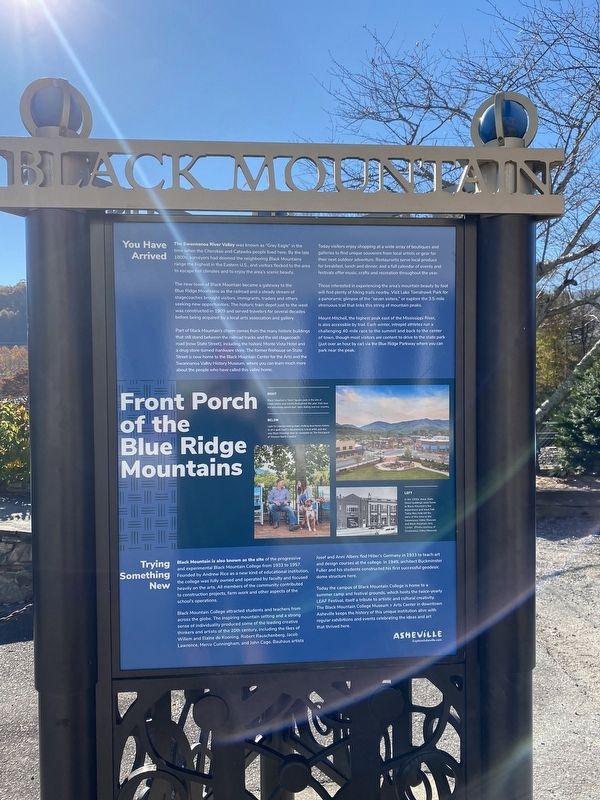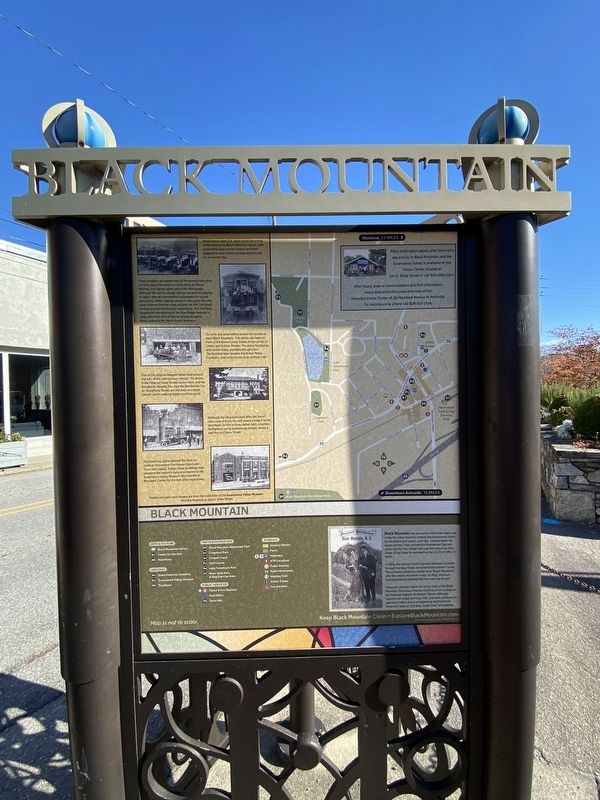Black Mountain in Buncombe County, North Carolina — The American South (South Atlantic)
Black Mountain
Front Porch of the Blue Ridge Mountains
You Have Arrived
The Swannanoa River Valley was known as "Grey Eagle" in the time when the Cherokee and Catawba people lived here. By the late 1800s, surveyors had deemed the neighboring Black Mountains range the highest in the Eastern U.S., and visitors flocked to the area to escape hot climates and to enjoy the area's scenic beauty.
The new town of Black Mountain became a gateway to the Blue Ridge Mountains as the railroad and a steady stream of stagecoaches brought visitors, immigrants, traders and others seeking new opportunities. The historic train depot just to the west was constructed in 1909 and served travelers for several decades before being acquired by a local arts association and gallery.
Part of Black Mountain's charm comes from the many historic buildings that still stand between the railroad tracks and the old stagecoach road (now State Street), including the historic Monte Vista Hotel and a drug-store-turned-hardware store. The former firehouse on State Street is now home to the Black Mountain Center for the Arts and the Swannanoa Valley History Museum, where you can learn much more about the people who have called this valley home.
Today visitors enjoy shopping at a wide array of boutiques and galleries to find unique souvenirs from local artists or gear for their next outdoor adventure. Restaurants serve local produce for breakfast, lunch and dinner, and a full calendar of events and festivals offer music, crafts and recreation throughout the year.
Those interested in experiencing the area's mountain beauty by foot will find plenty of hiking trails nearby. Visit Lake Tomahawk Park for a panoramic glimpse of the "seven sisters," or explore the 3.5-mile strenuous trail that links this string of mountain peaks.
Mount Mitchell, the highest peak east of the Mississippi River, is also accessible by trail. Each winter, intrepid athletes run a challenging 40-mile race to the summit and back to the center of town, though most visitors are content to drive to the state park (just over an hour by car) via the Blue Ridge Parkway where you can park near the peak.
Trying Something New
Black Mountain is also known as the site of the progressive and experimental Black Mountain College from 1933 to 1957. Founded by Andrew Rice as a new kind of educational institution, the college was fully owned and operated by faculty and focused heavily on the arts. All members of the community contributed to construction projects, farm work, and other aspects of the school's operation.
Black Mountain College attracted students and teachers from across the globe. The inspiring mountain setting and a strong sense of individually produced some of the leading creative thinkers and artists of the 20th century, including the likes of Willem and Elaine de Kooning, Robert Rauschenberg, Jacob Lawrence, Merce Cunningham, and John Cage. Bauhaus artists Josef and Anni Albers fled Hitler's Germany in 1933 to teach art and design courses at the college. In 1949, architect Buckminster Fuller and his students constructed his first successful geodesic dome structure here.
Today the campus of Black Mountain College is home to a summer camp and festival grounds, which hosts the twice-yearly LEAF Festival, itself a tribute to artistic and cultural creativity. The Black Mountain College Museum + Arts Center in downtown Asheville keeps the history of this unique institution alive with regular exhibitions and events celebrating the ideas and art that thrived here.
[Captions:]
Right
Black Mountain's Town Square pack is the site of celebrations and events throughout the year. Kids love the refreshing splash pad, open during warmer months.
Below
Look for colorful rocking chairs inviting downtown visitors to sit a spell. Each is decorated by a local artist, just one way Black Mountain lives its reputation as "the front porch of Western North Carolina."
Left
In the 1920s, these State Street buildings were home to Black Mountain's fire department and town hall. Today they help tell the story of this area as the Swannonoa Valley Museum and Black Mountain Arts Center. (Photo courtesy of Swannanoa Valley Museum
Horse drawn taxi (Ca. 1910) await the arrival of the train at the Black Mountain Depot. Later automobile taxis carried visitors and their baggage to local hotels and boarding houses for a summer day.
These travelers are aboard one of the tourist trains that ran from Black Mountain to Camp Alice on Mount Mitchell, the highest peak east of the Mississippi. Although the narrow gauge railway was laid for logging, in 1915 it also accompanied passengers for tourist excursions. When logging ceased in the 1920s the rails were removed and the route became the Old Toll Road, serving tourists traveling by automobile. The Toll Road closed with the opening of the Blue Ridge Parkway in 1935, and much of it is now on private property. (Photo courtesy of Mrs. Marion Perley Casstevens.)
Ox carts and automobiles shared the streets in early Black Mountain. This photo was taken in front of the Brown Livery Stable at the corner of Cherry and Sutton Streets. The stone foundation, still visible today, predates the 1912 fire. The building later became the Brown Motor Company, and today serves as an antique mall.
Few of the original elegant hotels built around the turn of the 19th century remain. The Monte Vista Hotel on State Street, shown here, and the Doughtery Heights Inn, now the Red Rockers Inn on Doughtery Street, are the only two which remain within walking distance of this point.
Although the structures built after the fire of 1912 are or brick, fire still posed a hazard to the downtown. In this picture, dated 1923, volunteer firefighters, using donated equipment, douse a roof fire on Cherry Street.
The booming 1920s allowed the town to build an impressive Fire House (1921) and Town Hall (1924). Today, these buildings help conserve the region's culture as homes to the Swannanoa Valley Museum (85) and Black Mountain Center for the Arts (87) respectively.
Photos and post card images are for the collection of the Swannanoa Valley Museum. Visit the Museum at 223 W. State Street.
Black Mountain has welcomed visitors for nearly two centuries. Early travelers entered the Swannanoa Valley by horseback and wagon, with later transportation by stage coaches. They crossed the Swannanoa Gap and came into the tiny village that was then known as Grey Eagle. (Gray Eagle as recorded by the U.S. Post Office in 1870).
In 1879, the Western North Carolina Railroad tunneled through the Blue Ridge and entered Buncombe County. The company named its station here "Black Mountain," after the nearby mountain range. In 1893, the town incorporated and adopted the new name as its own.
Today the restored depot sits in the heart of the Black Mountain Downtown Historic District, which is listed in the National Register of Historic Places. Although travelers no longer arrive by train, the town continues to welcome visitors and is an appealing destination to those who seek an "old time, small town" atmosphere.
Topics. This historical marker is listed in these topic lists: Arts, Letters, Music • Education • Industry & Commerce • Native Americans • Natural Features • Railroads & Streetcars • Settlements & Settlers. A significant historical year for this entry is 1870.
Location. 35° 36.949′ N, 82° 19.197′ W. Marker is in Black Mountain, North Carolina, in Buncombe County. Marker is on Sutton Avenue just east of Cherry Street, on the right when traveling east. Touch for map. Marker is at or near this postal address: 108 Sutton Ave, Black Mountain NC 28711, United States of America. Touch for directions.
Other nearby markers. At least 8 other markers are within walking distance of this marker. Grey Eagle (a few steps from this marker); George Winslow Whittington (within shouting distance of this marker); The Town of Black Mountain (within shouting distance of this marker); Up to Black Mountain (within shouting distance of this marker); The Center of It All (within shouting distance of this marker); Slavery by Another Name (within shouting distance of this marker); Hustle and Bustle (within shouting distance of this marker); Comings and Goings (within shouting distance of this marker). Touch for a list and map of all markers in Black Mountain.
Credits. This page was last revised on December 28, 2022. It was originally submitted on November 9, 2022, by Darren Jefferson Clay of Duluth, Georgia. This page has been viewed 185 times since then and 33 times this year. Photos: 1, 2. submitted on November 10, 2022, by Darren Jefferson Clay of Duluth, Georgia. • Devry Becker Jones was the editor who published this page.

